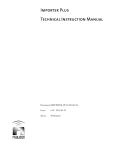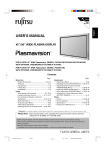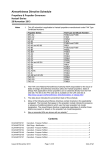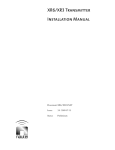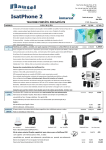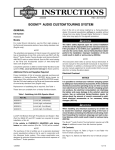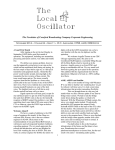Download XR3/XR6 - Nautel
Transcript
XR3/XR6 Frequency Change Procedure IS07012 Issue 1.0 ................10 September 2007 Nautel Limited 10089 Peggy's Cove Road, Hackett's Cove, NS, Canada B3Z 3J4 T.877 6 nautel (628835) or +1.902.823.2233 F.+1.902.823.3183 [email protected] U.S. customers please contact: Nautel Inc. 201 Target Industrial Circle, Bangor ME 04401 T.877 6 nautel (628835) or +1.207.947.8200 F.+1.207.947.3693 [email protected] e-mail: [email protected] www.nautel.com © Copyright 2007 NAUTEL. All rights reserved. IS07012 – XR3/XR6 Frequency Change Procedure INFORMATION SHEET 1 INTRODUCTION The XR3/XR6 is basically a broadband amplifier with fixed tuned elements in the RF drive stage and the RF output filter. The selection of frequency sensitive components and adjustment of variable inductors used in these circuits is normally performed at the factory at the transmitter’s assigned carrier frequency. When a frequency change is required, use the following procedures to realign the frequency sensitive components. 1.1 Equipment Affected This procedure applies to first release XR3/XR6 transmitters (Nautel Part # NARA48 and NARA49). 1.2 Responsibility for Implementation of Procedure This procedure should be carried out by qualified station maintenance personnel who are familiar with the XR3/XR6 transmitter. 1.3 Scheduling This procedure may be implemented at the convenience of station maintenance personnel. 1.4 Manpower Requirements It is estimated that implementing this modification will require eight (8) hours to complete. Note that it is necessary for the transmitter to be placed in an off-air status for the duration of this procedure. XR3/XR6 Frequency Change Procedure IS07012 1.5 Special Tools/Test Equipment The following test equipment is required. Where applicable, items are referenced in text. • • • • • • • • • • • • • • • • • Spectrum analyzer Oscilloscope Digital multimeter Vector impedance meter (e.g., Tomco TE1000) Function generator (audio to RF) Frequency counter Modulation monitor Audio test set (response and distortion) RF Current Probe(or Delta probe with meter) RMS voltage meter Delta RF current probe 200 Ω potentiometer Notch filter Attenuator pad Test cable (202-5010) Test load (176-5720-01) Computer with Microsoft® Excel® 1.6 Parts Required The frequency dependent parts required to change to the new frequency were shipped in the same package as this document. Part contents will vary depending on the new carrier frequency. Page 1 of 7 Issue 1.0 2 INSTRUCTIONS The frequency change procedure comprises four main steps: • • • • RF frequency change (see 2.1) Output filter tuning (see 2.2) RF power module tuning (see 2.3) Transmitter fine tuning/test (see 2.4) WARNING The XR3/XR6 transmitter uses a 312 V dc power supply. Use extreme caution when working near these lethal voltages. (a) Set the output power to 0 W, turn off the transmitter and turn off the ac power source. BCD switches 901 2.1 RF Frequency Change The RF synthesizer PWB(s), in each XR3/XR6, contains frequency dependent switches that select the carrier frequency and jumpers that are used to configure the PWB. 8 7 Use a small screwdriver to set binary coded decimal (BCD) switches S1 through S5 on each RF synthesizer PWB for the desired carrier frequency when they are read from left to right (S1 through S5). S1 x1000 (a) Set BCD switches S1 through S5 for the new carrier frequency, noting each switch represents a significant digit in the carrier frequency (expressed in kHz) as follows: - S1 is thousands digit (x1000) - S2 is hundreds digit (x100) - S3 is tens digit (x10) - S4 is units digit (x1) - S5 is the tenths digit (x0.1) See Figure 1 for switch location and examples of switch settings for specific frequencies. The arrow on the segment selector of each switch points to its numerical selection. Page 2 of 7 Issue 1.0 FREQUENCY (kHz) S2 S3 S4 x100 x10 x1 S1 x1000 654 2 3 8 7 1 901 654 2 3 8 7 2 901 654 2 3 8 7 9 S5 x0.1 901 654 2 3 8 7 4 901 654 2 3 0 1294 kHz 8 7 901 654 0 2 3 FREQUENCY (kHz) S2 S3 S4 x100 x10 x1 8 7 901 654 5 2 3 8 7 901 654 2 3 6 8 7 901 654 S5 x0.1 2 3 0 8 7 901 654 2 3 0 560 kHz Figure 1: Switch Setting Examples 2.2 Output Filter Tuning The next step is to change the output filter components according to the new carrier frequency. NOTE Some of the capacitors that are already installed in the transmitter’s three capacitor banks may be used at the new carrier frequency. Nautel’s Customer Service department will have checked the installed capacitors against the capacitors required for the new frequency and only provided the capacitors that are not already in the transmitter. XR3/XR6 Frequency Change Procedure IS07012 (a) Locate the transmitter configuration sheets that were included with the Proof of Performance documents shipped with the transmitter. Page # 1 of the configuration sheets includes the location and values of the capacitors that were installed at the factory. The capacitance value of each capacitor is stamped on the capacitor. (b) Using the Microsoft® Excel® spreadsheet, on the CD that was included with this document, enter the new carrier frequency and the site altitude in the appropriate fields. The spreadsheet will calculate the proper capacitor values, inductor tap settings, and spark gap setting for the new frequency. Refer to Appendix A at the end of this document for instructions on using the spreadsheet. Figure 2: Cap Bank 1, L1 and L2 (c) Carefully remove the capacitors from the three capacitor banks and check their stamped capacitance values (see Figures 2 and 3 for capacitor locations). Retain all hardware. NOTE When installing different sized capacitors in one capacitor bank, you may need to use spacer shims (Nautel Part # 202-6070 and/or 202-6070-01). Also note that M4 (4 mm), M6 (6 mm), and M8 (8 mm) hardware is used to secure the different size capacitors. When using a spacer with a Nautel Part # CS74 capacitor (200 pF), use the Nautel Part # HMSH15 bolt. (d) Using the spreadsheet’s calculated results, arrange the capacitors required for each of the three capacitor banks using the capacitors that were supplied with the frequency change kit and the capacitors that were removed from the transmitter. XR3/XR6 Frequency Change Procedure IS07012 Bank3 Figure 3: Cap Banks 2 and 3; L3, L4 and L5 CAUTION When installing capacitors, do not over-tighten securing hardware or allow hardware to bottom out on the capacitor body. Failure to observe this caution can cause a mechanical failure of the capacitor. Page 3 of 7 Issue 1.0 (e) Install the capacitors in each bank using hardware from the frequency change kit and retained hardware. Try to distribute the capacitors within banks 1 and 2 so that both ground plates are supported (e.g., if installing two capacitors in bank 1, install one in the upper left location, C1, and the other in the lower right location, C6). (f) Using the spreadsheet’s calculated results for Initial Number of Turns, set the taps for inductors L1 through L6, in the rear of the transmitter (see Figure 4). NOTE: Tap connections are made using quick disconnects and the shorting jumper should be installed across unused turns, with a spacing of two coil taps between the tap and the shorting jumper. Shorting Jumper QuickDisconnect Taps Turns In-Circuit (h) Use a set of feeler gauges to set the spark gap, located to the right of capacitor bank 3, for the Spark Gap distance (in inches) indicated on the spreadsheet. 2.3 RF Power Module Tuning (a) Remove all RF power modules from the transmitter. One at a time, set an RF power module near the front of the transmitter, so that the test cable can be connected. NOTE If necessary, refer to the XR3/XR6 Troubleshooting Manual for RF power module assembly detail drawings as well as connection and tuning procedures referenced in this section. (b) Remove both side covers from the RF power module. Remove the cover from the RF drive tuning assembly. Loosen the locking nut on the feed screw. Reinstall the cover on the RF drive tuning assembly. (c) Connect the test cable (Nautel Part # 202-5010) and the test load (Nautel Part # 176-5720-01) to the RF power module. Figure 4: Inductor (L1 through L6) Taps (d) Apply ac power to the transmitter and set the RF output to 0 W by pressing the Power – Increase and Power – Decrease buttons simultaneously. Press RF On. (g) Set the taps for inductors L3, L4 and L5 by loosening the clamp screw on the inductor’s tap clamp and moving it to the position indicated on the spreadsheet in the Initial Number of Turns section. NOTE: Count the turns from back to front on inductors L3 and L5 and from bottom to top on inductor L4 (see Figure 3 for inductor location). (e) Monitor TP14 and TP15 of the module’s RF drive control PWB with an oscilloscope. Adjust the RF drive tuning manually, using a 10 mm nut driver, until the zero-crossing points of the TP14 and TP15 waveforms coincide (see Figure 5). The voltage at the gate lead of the FET in any PA shall be between 22 and 25 V pp. Page 4 of 7 Issue 1.0 XR3/XR6 Frequency Change Procedure IS07012 (c) Monitor J5 on the RF drive buffer PWB with an oscilloscope. Adjust the RF synthesizer PWB’s SYMMETRY potentiometer (R32) for a 50% duty cycle on the oscilloscope. (d) Select exciter B (see XR3/XR6 Operations and Maintenance Manual) and repeat steps (b) and (c). (e) Turn off the ac power. Figure 5: RF Power Module Tuning (TP14 and TP15) (f) Follow the procedure in the XR3/XR6 Troubleshooting Manual to remove the RF power module from the test cable. Remove the tuning assembly’s cover and tighten the locking nut. Reinstall the tuning units cover and the modules both side covers. (g) Install the RF power module in the transmitter. (h) Repeat steps (b) through (g) for the second (if applicable) RF power module. (i) On the transmitter’s GUI screen press the Status soft key. From the Status screen press the Reset soft key. The alarms on the RF power modules should clear as well as any alarm LEDs on the control panel. All red LEDs should now be off. 2.4 Transmitter Fine Tuning/Test 2.4.1 VERIFY FREQUENCY 2.4.2 MONITOR PA VOLTAGE, RF VOLTAGE AND RF CURRENT Monitor PA voltage on the front panel GUI and use an oscilloscope to monitor the RF voltage and RF current at the back of an RF power module. place the voltage probe on this point place the current probe on this twisted wire pair Figure 6: Monitoring PA Voltage and RF Current (a) Install the RF current probe and connect the RMS voltage meter as shown in Figure 6. NOTE that current will flow from the plug to the inductor. Reinstall the transmitter’s rear cover, taking care not to damage the probe or voltage meter leads. (a) Turn on the ac power. (b) Monitor TP7 on the RF synthesizer PWB with a frequency counter and oscilloscope. The oscilloscope should display a 15 V (approx.) square wave at the frequency set in 2.1.1. XR3/XR6 Frequency Change Procedure IS07012 (b) Apply ac power to the transmitter and press RF ON. Increase the power until the PA voltage (measured on the GUI) is 40 V. The RF output current should be 3.45 ± 1 A. If the RF current exceeds 4.45 A recheck filter tuning and verify that there are no shorts in the filter. Page 5 of 7 Issue 1.0 (c) While monitoring the RF current and voltage, ensure that the RF current lags the RF voltage by at least 40 ns (see Figure 7). (b) Apply ac power to the transmitter and press RF On. Increase the RF output to 6 kW for an XR6 or to 3 kW for an XR3 and monitor the second and third harmonic levels on the spectrum analyzer. (actual waveforms may contain ringing) (c) Carefully adjust the SYMMETRY potentiometer (R32) on the active exciter’s RF synthesizer PWB to minimize the second harmonic. Switch to the other exciter and adjust the SYMMETRY potentiometer (R32) on that exciter’s RF synthesizer PWB to minimize the second harmonic. V t = 40 ns Figure 7: Current Lagging Voltage (d) Increase the PA voltage to 70 V. The RF current should be 6 A ± 2 A. Verify that the RF current lags the RF voltage by at least 40 ns. (e) Increase the PA voltage to 130 V for an XR6 or to 90 V for an XR3. The RF current should be 11 A ± 1 A for an XR6 or 7.75 ± 1 A for an XR3. Verify that the RF current lags the RF voltage by at least 40 ns. 2.4.3 MINIMIZE HARMONIC CONTENT WARNING To avoid personal injury, the transmitter must be in an RF Off state with ac power switched off during adjustments made in this section. (a) Install the RF current probe (Delta probe) in the transmitter’s RF output feed line. Terminate the current probe with a suitable dummy load and spectrum analyzer. NOTE: Each side of the RF filter cover must be tightly secured with at least one screw while the transmitter is in operation. Page 6 of 7 Issue 1.0 (d) Set the spectrum analyzer’s marker on the third harmonic peak and note the level. If the level is more than 80 dB below the carrier, no adjustment is required. If not, press RF Off and switch off the ac power to the transmitter. (e) Gain access to the RF output filter and make a small adjustment to inductor L4 (see Figure 3) by moving the L4 coil clamp to add or subtracting a few inches of coil. (f) Install the cover on the output filter, apply ac power, and press RF On. Check the level of the third harmonic compared to the level noted in step (d). If the level increased the coil clamp was moved in the wrong direction. If the level decreased the coil clamp was moved in the correct direction. Continue adjusting until the third harmonic can no longer be reduced. XR3/XR6 Frequency Change Procedure IS07012 2.4.4 FINE-TUNE RF FILTER INPUT IMPEDANCE Fine tune the RF filter input impedance by adjusting inductors L3 and L5. WARNING To avoid personal injury, the transmitter must be in an RF Off state with ac power switched off during adjustments made in this section. (a) With the transmitter operating at 6 kW (XR6) or 3 kW (XR3) into a 50 Ω j0 load, note the current reading on the Delta RF current probe. The current should be 11 A for an XR6 or 7.75 A for an XR3 and the RF current waveform should be lagging the RF voltage waveform on the oscilloscope by between 40 and 120 ns. (b) If the RF current is not 11 A for an XR6 or 7.75 A for an XR3 and/or the current waveform in not lagging by between 40 and 120 ns, adjust the input impedance. Press RF Off and switch off ac power to the transmitter. (c) Gain access to the output filter and make a small adjustment to either the L3 or L5 inductor. Install the cover on the output filter, apply ac power, and press RF On. (d) Recheck the RF current probe for 11 A for an XR6 or 7.75 A for an XR3 and the current waveform lag time. Continue to make small adjustments until both conditions are met. (e) When the conditions in step (a) are met, use an audio distortion set to measure the transmitter’s frequency response and distortion. The Delta RF current probe can be used as the RF sample for these measurements. Use an attenuator to control the RF level and a notch filter to notch the carrier level by about 20 dB. Minor adjustments may be required to L3 and L5 in order to get acceptable frequency response and distortion measurements. XR3/XR6 Frequency Change Procedure IS07012 2.4.5 ADJUST RF CURRENT ALARM (a) With the transmitter switched RF Off and ac power removed, remove any resistors mounted on the pins in the R86 and/or R87 positions on the distribution PWB. Install a 200 Ω potentiometer, set to 200 Ω, on the pins in the R86 position. (b) Apply ac power and press RF On. Set the transmitter’s RF output power to 6.6 kW for an XR6 or 3.3 kW for an XR3. (c) Measure the voltage on TP9 of the distribution PWB and adjust the potentiometer installed in the R86 position until the voltage is 1.65 V dc ± 0.05 V. (d) Press RF Off and switch off the ac power to the transmitter. Carefully remove the potentiometer from the pins at R86 and measure the resistance. (e) Use fixed resistors to make an equivalent resistance to that measured in step (d). Install the equivalent resistance on the pins at R86 and R87. If two resistors are required to make up the equivalent resistance, install one resistor in each location (the R86 and R87 locations are in parallel). (f) Apply ac power to the transmitter and press RF On. Check the voltage on TP9 on the distribution PWB. If the voltage is not 1.65 V ± 0.05 V repeat steps (a) through (e). (g) When the RF current threshold has been properly set press RF Off and switch off ac power to the transmitter. Remove all test equipment and install all of the RF filter cover screws. (h) The transmitter is ready to be placed back into service. Page 7 of 7 Issue 1.0 XR3/XR6 Frequency Change Procedure IS07012 (APPENDIX A) Page 1 of 1 Issue 1.0











